Catholic Customs
 |
 |
 |
 |
 |
 |
 |
Honoring St. Michael on His Feastday
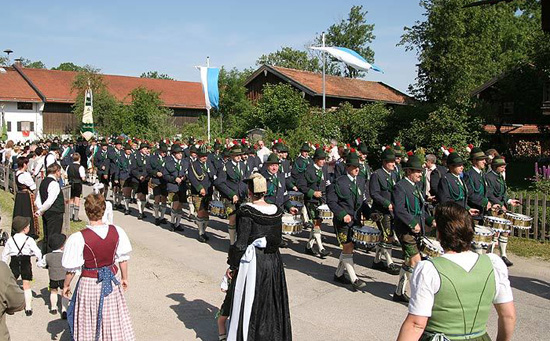
A Michelmas Procession in upper Bavaria
image BROKER.com & CO. KG
Goose, lamb & feasting food
All over Europe, Michaelmas marks the end of harvesting, fishing, fruit picking and other summer activities. Catholic peasants especially invoked St. Michael during these autumn months for protection in the dark months of winter that were approaching. From this day forth, peasants in northern countries would begin lighting candles in their homes in the evenings.
Michaelmas comes at the time of the year when the wheat harvest is complete and the cattle and fowl are fattened. For this reason, the feast day was a perfect time for harvest festivals, with tables abounding with with plump geese and harvest grain bread. The abundance of harvest food led to the good custom of sharing the harvest feast with the poor.
In Ireland and throughout the British Isles, Michaelmas celebrations had three characteristic symbols: "glofe, gees, and gyngeuer" (gloves, geese and ginger). "The glove represented the open-handedness and generosity of the lord of the village, eating goose brought good luck in the coming year, and ginger provided protection against infection."
Some Michaelmas customs regarding the magistrates show well the glove's symbolism. In nations observing quarter days, the election of magistrates took place on this feast. The medieval man saw the connection between their earthly rulers and the celestial protectors. What better way to acknowledge St. Michael than to choose the men who would protect and guide the inhabitants of their town or city on the Archangel's feast day?
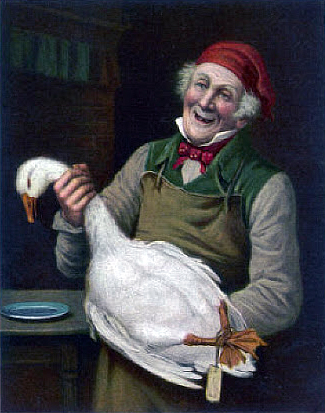
He who eats goose on Michaelmas day,
Shan’t money lack or have debts to pay
On this day the traditional dish was a roast goose in Germany, the British Isles and other places on the Continent. Some nations on the Continent reserved this custom for Martinsmas. The Michalmas goose was carefully fattened by the gleanings from the stubble in the grain fields to be properly plump by September 29.
According to tradition, if the breast bone was brown after roasting, a mild winter would ensue, however, blue tinted bones indicated a harsh winter.
People who did not eat goose celebrated with other meats that crowned their table. In Eastern Finland and parts of Scotland and Ireland, it was traditional to slaughter a lamb on Michaelmas.
Carrots, blackberries & bread
In Scotland, the Sunday preceding Michaelmas was known as Domhnach Curran (Carrot Sunday). The women of the Hebrides would dig carrots the Sunday before Michaelmas in a special ceremony. The women used a three-pronged mattock (symbolizing St. Michael's trident) to dig triangular holes (symbolizing Michael's shield); as they dug they honored St. Michael reciting verses or poems.
The carrots were tied into bundles with red three-plied thread and buried in sand to be used throughout the year. Any guest who entered a house on Michaelmas was given one of these bundles. Everyone in a Scotch house, visitor and guest, stranger and servant, had to eat a piece of St. Michael's Bannock (Straun Micheil), which earned them some title to the friendship and protection of Michael. Michael's Bannock was made of equal portions of each of the various grains harvested that year, moistened with sheep's milk and often marked by a cross.
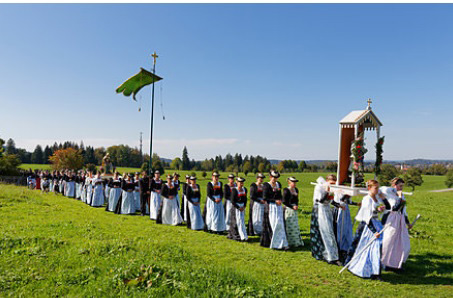
Through the countryside of Gissach (Bavaria), ladies lead a Michaelmas procession;, also commemorated in the streets of Fürth, below

In Ukraine, it was believed that the more guests that were entertained in the house on Michaelmas Day, the richer the family would live in the coming year. The meal began with the men sitting at the table and sampling the meat, with the first piece being given to the guest of honor who was placed in seat nearest the icon of St. Michael.
It was a popular belief among the peoples of the British Isles that it was unlucky to gather blackberries on or after Michaelmas. According to legend, when St. Michael thrust the Devil out of Heaven, Satan landed on a blackberry bush.
The Devil returns every year after Michaelmas day to take his revenge on the plant that reminds him of his defeat; he spits and stamps on the plant, making it poisonous and unfit to eat. So the people were careful to pick all the blackberries before Michaelmas to make their delicious blackberry jams and pies.
In northern Europe, England and the Germanic nations, the wine that was drunk on this great feast day was called Michelsminne (St. Michael's Love).
Michaelmas fairs & the shepherds return
All over Europe this day brought St. Michael's parades, Michael's fairs, and Michaels plays. At the fairs, the peasants and shepherds would celebrate the Archangel as they traded crops, animals, clothing, firewood and other items necessary for the cold months that were approaching.
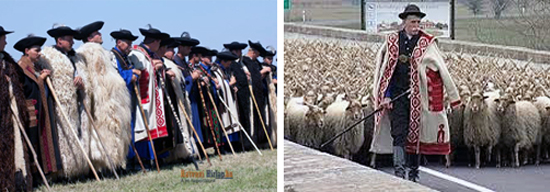
Hungarian shepherds in traditional dress for the Michelmas procession,
at right, a shepherd bringing down his sheep from pasture
In Hungary and Poland, the shepherds would be welcomed by the owners of the sheep and receive their wages. After the Mass, the villagers, especially the sheep farmers, would host a large feast with dancing and music to celebrate the return of the shepherds.
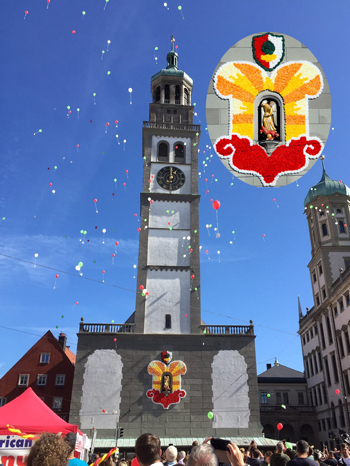
Crowds gather to watch St. Michael strike the devil at the Turamichele Fest, Augsburg
Since 1526 in Augsburg, Germany, an autumn fair known as the Turamichele Fest (Michael Tower Market) is held which attracts peasants from near and far. The festivity highlight is the appearance of a figure of the warrior Angel St. Michael slaying the ignomious serpent Satan on the Perlach Tower at every hour. The arm of St. Michael moves, striking Satan with a lance as many time as the bell tolls.
Processions
Throughout Spain, Portugal, Italy and Latin America processions took place to honor the great Archangel.
In Torrejón el Rubi, Spain, the statue of St. Michael is processed through the streets with four young men (paseantes) walking before it and carrying swords or other symbols of St. Michael. On their chests they wear red bands bearing the inscription "Quien Cómo Dios" ("Who is like God"). Every few steps the men turn around and ceremoniously bow before the statue.
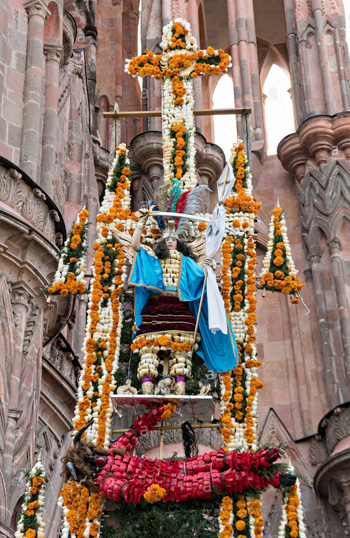
St Michael crushing the Devil in the Michaelmas procession in San Miguel de Allende, Mexico
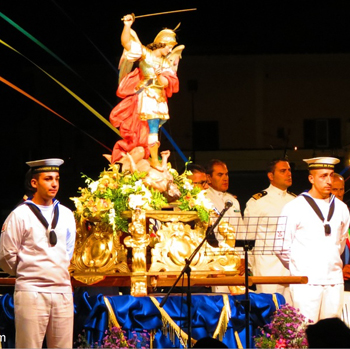
In honor to St. Michael a boat parade
in Sant'Angelo, Italy
In Sant'Angelo, Italy, another village dedicated to St. Michael, the people celebrate with a procession in boats on the sea. A principal vessel carries the statue of St. Michael, followed by many other small boats. The people enthusiastically honor the Archangel by lighting fires and candles along the shoreline and setting off spectacular fireworks.
The feast in your home
This feast could easily be incorporated into Catholic homes and is especially important because of the great need for the aid of St. Michael in these times when the power of the Devil has been unleashed.
A grand feast can be prepared with goose, duck, chicken, lamb, or even ham. Whatever the meat, present it on a beautiful tray surrounded by side dishes of the fruits of the harvest. If you have a farm or a garden, you should strive to decorate the table with some of your crops, flowers and grain sheaves as a sign of the harvest's end, asking St. Michael for his special assistance through the upcoming colder and darker months.
A warm loaf of homemade harvest bread, or Bannock, would be a fitting traditional addition to the meal. Blackberries, apples, ginger and carrots can be incorporated in various ways (pies, crumbles, sauce, cake, gingerbread, etc) and would add special charm because of the symbolism and legends attached to them.
The Aster (Aster amellus), known in Catholic England as the Michaelmas Daisy, was named after St. Michael. In many places Michaelmas daisies were collected on this day to adorn clothing and the house. How fitting an addition these beautiful flowers would make to the table.
In Lincolnshire and Yorkshire, the people would add festivity to the day with the singing of ballads, telling of stories and making of bonfires. These activities, along with processions and prayers, add a joy to the feast day that a meal alone cannot give.
Let us give St. Michael due honor on his special day so that he may lead us in our fight against the Devils, who are striving more than ever to destroy the Church, families and Catholic Civilization.
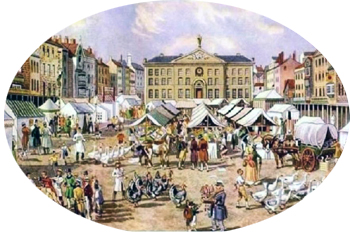
Michelmas Goose Fair in Suffolk, England

Posted September 26, 2020
______________________
______________________
 |
 |
 |
 |
 |
 |


